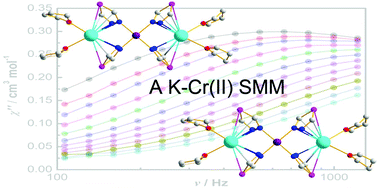1,2-Diaza-4-phospholide complexes of chromium(ii): dipotassium organochromates behaving as single-molecule magnets†
Abstract
The 1,2-diaza-4-phospholide (dp−) dipotassium ate complexes of chromium(II) {[(η1-N-3,5-tBu2dp)4Cr][(η5-(N,N,C,C,P))2-K(η1-O-THF)2]2} (5) and {[(η1-N-3,5-Ph2dp)4Cr][(η5-(N,N,C,C,P))2-K(η1-O-THF)2]2}∞ (6) were synthesized and characterized by X-ray single crystal structure analysis. Complex 5 with a near-square planar geometry at the chromium(II) ion was unambiguously characterized by the high field electron paramagnetic resonance (HF-EPR) technique and magnetic measurements, revealing that it is a field-induced single-molecule magnet (SMM).



 Please wait while we load your content...
Please wait while we load your content...